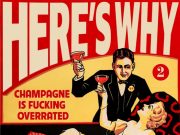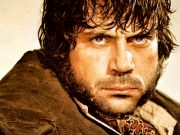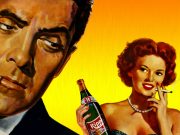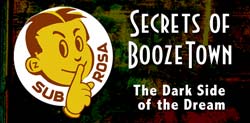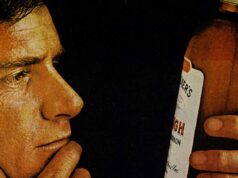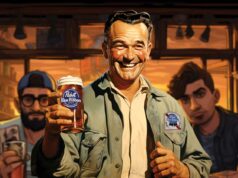
We all dream of a homeland for drunks, but one visionary spent much of his life trying to make that dream a reality. This is his story.
It’s 1952 and Mel Johnson is hustling his dream. His audience is captive: the dozen businessmen, self-styled playboys and wealthy widows sit in a reserved club car of the Denver Zephyr, hurtling between Chicago and its namesake. Mel’s lanky frame, youthful face and nervous energy bely his 40 years—from ten paces you’d swear he was some goofy kid in his late-20s.
Mel has spent the past hour getting the potential investors liquored up and it’s time to make his pitch. He has no charts, blueprints or prospectus to show them. What he does have are matchbooks, cocktail napkins and drink menus from bars that have never existed—ephemera from fantasy land.
Just imagine, he asks his audience, a resort entirely centered on the culture of alcohol. A boozer’s paradise built expressly to facilitate drinking and the good times that naturally follow. Where the bars, clubs and liquor stores never close. Where the police force is there to help drunks, not hassle them. Where even the street names salute sweet mother booze: Gin Lane, Bourbon Boulevard and Scotch Street. An adult playground like no other. Just imagine.
The Quest for El Dorado
“Mel loved to drink,” says Emma Halverson, Mel’s cousin and heir. “He started pretty young, I guess. He didn’t have much parental supervision.”
So it would appear. A careful study of Mel’s journals, graciously provided by Mrs. Halverson, reveals that Mel loved everything about the drinking experience: the taste, the joy, the tradition, the camaraderie, the madness, the adventures. Especially the adventures. Mel spent five years, between 1946 and 1950, restlessly crisscrossing the globe, drinking his way through the great libertine cities of Dublin, London, Havana, Barcelona, Rio, New York, New Orleans and Paris. He would later realize he was subconsciously and systematically searching for the El Dorado of alcohol, the mythical golden city with the perfect drinking scene. The manner of fleeting paradise the Lost Generation had found in Paris in the 1920s. If it could no longer be found in the City of Lights, if the war had chased it away, it must have gone somewhere else, right?
Mel never found it. None of the cities and scenes were ever quite right. Finally, during a night of heavy drinking in the Old Absinthe House in New Orleans, he had an epiphany: if the golden city of El Dorado did not exist, if it was just a fanciful myth, well, then he would have to build it himself.
He briefly flirted with the idea of opening a nightclub in New Orleans then backed out. He realized it would not have been enough; it would have been a marriage of compromise certain to bring disappointment and, worse, a sense of obligation that would thwart his true destiny.
If he were going to fully commit himself, he decided, it would have to be to something much grander, something on an epic scale. El Dorado was no mere golden palace, after all—it was a golden city.
Meet Mel Johnson
“Every man has a dream,” Voltaire noted, “but few are brave or crazy enough to pursue it.” It just so happened that Mel Johnson was plenty brave enough. And he wasn’t exactly short on crazy, either.
It could be said that Mel’s personality was mainly a gang of idiosyncrasies and quirks bound together by unbridled enthusiasm. He was an extremely intelligent man, and like many of those, somewhat eccentric. It showed from an early age. He’d spend most of his childhood, when he wasn’t in boarding school, in either London with his dissolute playboy father or in Cincinnati with his staid and sickly mother. Neither parent seemed terribly interested in raising a child, and Mel was left to his own devices. He was expelled from three different boarding schools for antisocial behavior. A brilliant, if undisciplined, student, he managed to get into Harvard University only to drop out two years later. He spent three years in Mexico as a mining speculator, without much success.
When America became embroiled in World War II, he enlisted with the U.S. Army Air Corps in 1942 at the age of 30, hoping to become a fighter pilot. Instead he was shipped off to England as a radio operator. He was discharged in 1944 with a Section 8 after a failed attempt to burn down the base officer’s club. When the war ended, Mel began his travels, eventually returning to Ohio to plan his great city.
Picturing Paradise
 At the end of 1950, Mel was a man obsessed. Made restless by his extensive post-war travels, he spent every waking hour sketching in the details of his dream. First, of course, he’d need to put a name to his drunkard homeland. He considered many possibilities, including El Dorado, Boozeville and Lush Land, before finally settling on the portmanteau BoozeTown.
At the end of 1950, Mel was a man obsessed. Made restless by his extensive post-war travels, he spent every waking hour sketching in the details of his dream. First, of course, he’d need to put a name to his drunkard homeland. He considered many possibilities, including El Dorado, Boozeville and Lush Land, before finally settling on the portmanteau BoozeTown.
Next he began the task of defining what exactly BoozeTown would be. He imagined it coming to life in three stages.
Stage One: BoozeTown would begin as a vacation resort comprised almost entirely of bars. Not just any bars, but theme bars promising a wide array of experiences. Among others, there was to be a Old West saloon, a medieval pub, a Casablanca-style night club, an art-deco speakeasy, a Cuban-style dance hall, a pirate den and even a jungle bar where monkeys would roam free. Large nightclubs would feature dance revues and the popular singers and comics of the day. In the middle and above it all, Mel would erect his headquarters and home: a tall gleaming tower shaped like a thick-stemmed martini glass. Its rooftop garden would feature an olive grove to keep the city’s martini drinkers supplied with fresh garnish.
Stage Two: Once enough revenue rolled in, the infrastructure would be expanded. A transportation network would be put in place, including moving sidewalks (why stagger when you can stand?) and an electric trolley system (the BoozeCruise) to whisk drunks safely from bar to bar.
It goes without saying that Mel wanted to manufacture his own booze, so Stage Two would also entail the erection of a distillery and brewery, even a winery if the local climate and soil permitted. The alcohol would be of such high quality he felt certain he would corner the sizable BoozeTown market. While outside alcohols would be made available, he hoped to instill a patriotic spirit that would encourage visitors and residents alike to choose the hometown offerings.
Stage Three: With the means of production firmly in hand, Mel would focus on population growth. Permanent living quarters would be built—residential towers and proper suburbs. Mel envisioned his colony as the perfect home for “retirees, scribblers, artists and other goof-offs.” Mel figured that many of the hard-drinking writers, actors and artists he admired would want to live there, amongst their own, and they in turn would attract the less famous. Mel was also certain, once these great drunken talents had gathered, brilliant works of art—be they novels, plays, paintings or music—would arise from the creative hive of BoozeTown. Then the outside world would be forced to sit up and salute his city as a great incubator of art.
The uniqueness of its central theme aside, BoozeTown would boast many other distinguishing characteristics.
Novel Notions
Revolutionary Roads
Initially Mel planned to lay out BoozeTown on an orderly grid, with the north to south streets alphabetical and the west to east streets numerical. This, he figured, would make it nearly impossible to get lost not matter how deep in your cups. But memories of Dublin and Paris convinced him a winding, illogical layout would add more mystery and adventure to the experience. That getting lost was oftentimes more valuable than getting where you imagined you needed to go.
Furthermore, every street’s name would allude to alcohol in some way, so drunks could gaze around and think, yes, we’re in charge here, we own this place, this is our homeland.
Interestingly, the proposed names of the main thoroughfares surrounding central BoozeTown all referenced the US Repeal of Prohibition: Repeal Road, FDR Drive, 21st Amendment Avenue. It was as if Mel wanted to surround his city with mystical walls of protection against future attempts to quash drinking.
Not that he was unwilling to give the opposition their due. The Volstead Sewer Treatment Plant would be named for the architect of Prohibition.
Healthy Hooching
Something of a vitamin freak, Mel planned to infuse the homegrown beer and liquor with vitamins and minerals. This way drunks could remain healthy even during those periods when merrymaking trumped meals.
24-Hour Party People
Mel adhered strongly to the idea that an adult is an adult all the time, that his rights should not expire at certain hours. “There is nothing worse in this world,” Mel wrote in his journal, “than to be awake during the small hours and have no place worth going to.” And as a lifelong insomniac, it’s likely he found himself in that position quite often.
So it’s no surprise that “Where It’s Always Happy Hour” became one of the main slogans attached to BoozeTown. Mel meant it. Every bar and liquor store would be open 24 hours a day, seven days a week. Furthermore, you’d have the right to bring your drink with you anywhere you liked, including banks, post offices, and places of worship.
BoozeBucks
BoozeTown would boast its own currency: visitors would exchange their US dollars for BoozeBucks upon entrance. Each buck would be backed by “liquid gold”—a vast vault stocked with barrels of whiskey at the BoozeTown Bank. The way Mel figured it, whiskey, as it aged, always appreciated in value, eliminating the possibility of inflation. No telling how the US Treasury Department would have felt about this grand notion.
The Party Police
BoozeTown would be patrolled by its own security force, the Party Police. Though a bit ominous in sound, the Party Police’s job would be to facilitate rather than inhibit the fun. Being drunk would never be a crime. Instead of being arrested and tossed into the drunk tank (something Mel had no small amount of experience with), those who found themselves a bit too overwhelmed with joy would be politely escorted home by helpful officers. These kind-hearted fellows would even administer aspirin as needed and tuck revelers safely into bed.
Booze News
A hometown newspaper, the BoozeTown Bugle, would keep visitors and residents informed. Reinforcing the escape fantasy, the news would be very insular; the outside world would barely be mentioned. Naturally, Mel envisioned himself as the editor-in-chief.
Adults Only
No children would be allowed in BoozeTown. Mel felt children got in the way of adult fun. Visitors with children would have the option of parking the kids at a sprawling day care center/summer camp complex located just outside the main gate.
In the Middle and Away From It All
But where to build BoozeTown? Logically, it would have made sense to choose a state with liberal drinking laws and warm weather, such as Louisiana or Nevada. But Mel desperately wanted his colony to be located in Middle America, particularly in his home state of Ohio. He didn’t want to hide it away in a desert or swamp, he wanted it right up front and in the middle.
But also isolated. He felt BoozeTown should present a “much needed opportunity to escape the grinding hell of the workaday world” and that meant many miles of open space between his dream and reality.
He initially entertained the idea of building on a large family-owned tract 30 miles outside of Steubenville, Ohio, but was thwarted by the severity of local drinking laws. The county government failed to grasp the brilliance of a resort built around the idea of round-the-clock boozing, no matter how many tourist dollars it would pour into the local economy. They thought the concept sinful.
After scouting other sites in the Midwest and opening up lines of dialogue with the local governments, he slowly came to realize he was spinning his wheels. As the years progressed, he looked at sites in northern Nevada (he was leery about getting too close to Las Vegas) and even an island off the western coast of Mexico.
Postcards From Never-Never Land
Mel had the habit of getting ahead of himself. Before he raised a single dollar for his project, Mel engaged graphic artists and print houses and began cranking out a wide array of ephemera, including maps, posters, post cards, matchbooks and cocktail napkins. He was also possessed of the habit of announcing wildly optimistic and ever-advancing inception dates of BoozeTown’s unveiling. It was as if he believed that creating the trappings and timeline of BoozeTown would somehow force it to spring into existence.

The Price of Paradise
Building a city from scratch, of course, requires a great deal of capital. Mel was not entirely without resources. His playboy father, the son of a shipping tycoon, had died in a skiing mishap in the French Alps before he could squander the entire family fortune, and Mel inherited about a quarter million dollars at the age of 17. He wisely invested in uranium mines in the late ‘40s, which he subsequently sold to the government for a healthy profit. In 1951 Mel was worth about a half million dollars.
Which was a good start, but not nearly enough. By Mel’s estimation, he’d need a cool $5 million (roughly $40 million in modern dollars) to build BoozeTown. Not that much when you consider Walt Disney spent $17 million building Disneyland. But while Walt had Disney Studios and ABC Television to back the bill, Mel would have to summon his missing millions from a wide array of investors.
Details are hazy, but Mel probably held his first fund-raiser in Cincinnati in January 1951, in the form of a masquerade party for the Midwest’s monied elite. All his fundraisers and investor mixers were parties; Mel found alcohol helped people absorb the beauty of his idea. The problem was, they always sobered up. Once he realized the Midwest wasn’t going to cough up the cash, he began throwing his fundraisers elsewhere. He conspired extravagant costume parties in foreign capitals, he rented chalets in the Alps and hosted well-attended weekend getaways. He’d met a lot of the monied playboys during his earlier travels and surely they, of all people, would recognize the brilliance of his scheme.
Mel Vs. Mel
If the sheer audacity of his plan wasn’t problem enough, Mel had another large obstacle, namely himself. When Mel became frustrated, as he often did during his pitches, he had the disconcerting habit of shouting at God. In the middle of a sentence, he would suddenly raise his baleful eyes to the heavens and shake a fist at the Almighty, loudly inquiring as to why He was so interested in thwarting him at every turn.
Mel’s growing paranoia was another problem. He became convinced that once his intentions became widely known, others (he especially suspected the Mob) would steal his idea and beat him to the punch. He made all his potential investors sign a non-disclosure agreement before he’d breathe a word, and even then he was vague with the details, which made it difficult to sell his idea to stark outsiders.
Mel was also very disdainful of feedback. He wanted their money, not their input. He was deathly afraid of compromising or losing control of his dream; his glorious vehicle had room for only one driver, and that driver was Mel. Everyone else could kick in gas money and shut the hell up.
His paranoia also extended to the government. Mel was certain he was being shadowed by the FBI—not such a crazy idea when you consider J. Edgar Hoover’s since-revealed penchant for keeping tabs on radical thinkers.
Pummeled by the Press
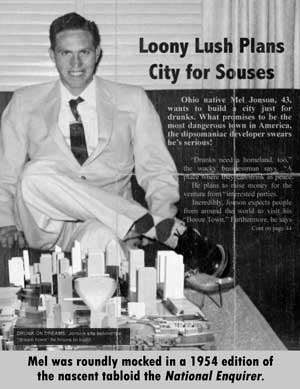 The media wasn’t helping matters. Initially eager for free publicity, Mel quickly learned that not everyone, especially cynical newspaper reporters, took his idea seriously. The Plain Dealer called his project “an unlikely scheme” and suggested that Mel was trying to build “a modern Gomorrah” for “society’s rejects.” The article closed with a snarky plea that Mel should seek psychiatric help.
The media wasn’t helping matters. Initially eager for free publicity, Mel quickly learned that not everyone, especially cynical newspaper reporters, took his idea seriously. The Plain Dealer called his project “an unlikely scheme” and suggested that Mel was trying to build “a modern Gomorrah” for “society’s rejects.” The article closed with a snarky plea that Mel should seek psychiatric help.
Mel was also featured in one of the first issues of a nascent tabloid called the National Enquirer. In the piece, titled “Loony Lush Plans City for Souses,” Mel is described as “raving,” “cock-eyed” and “a lunatic.” To add incompetence to injury, they also misspelled his name. Mel would insist that the article was a hit piece ordered by the Mob, who were interested in protecting their investment in Las Vegas.*
*Mel’s claim may not have been so far-fetched. It was recently revealed that the tabloid was purchased in 1952 with funds borrowed from Mob boss Frank Costello, and the Mob exercised a certain amount of editorial control.
Teetering on the Brink of Success
Despite these sundry handicaps, on three separate occasions Mel felt confident he had the money in place. So confident that, each time, he attached a definite year to his posters and ads, instead of the usual “Coming Soon!” In 1953 he thought he’d corralled a group of Texas cattlemen, but they, according to Mel’s journal, soon revealed themselves to be “professional bluffers and bull-shitters.” In 1955, it was a consortium of European industrialists who eventually transformed into “a gang of swindlers.” In 1958, it was an unnamed “noblewoman with more money than brains.” She turned out to be a lunatic with little money and a fake title.
Each time he thought he had his hands on the lever, it disappeared into smoke. It was probably with no small amount of chagrin that Mel watched Walt Disney open his alcohol-free theme park in 1957. If the kids deserved a vast playground, he must have wondered, why didn’t adults?
Paradise Lost
Mel officially gave up on BoozeTown in 1960. He came to regret not using his own fortune to start small, to build upon a single bar, but by then it was too late; he had travelled so far into his fantasy world that was there no going back or starting over. He’d labored frantically for a decade, spent an untold amount of his personal fortune and came away with nothing.
In his journal Mel would blame many for his failure, including the U.S. Government, “Christers,” the Mob, and J. Edgar Hoover. Everyone except himself.
In 1962, at the age of 50, Mel was diagnosed a paranoid schizophrenic and placed in the custody of the Bartonville Mental Hospital near Peoria, IL. Exactly who put him there and under what exact circumstances is, according to Emma Halverson, a matter of private family history.
A broken man, Mel died in captivity four years later. It is interesting to note that, according to parapsychologists, Mel’s ghost (among others) still haunts the now abandoned facility.
What May Have Been
It’s nearly impossible to say exactly how close Mel came to realizing his dream. Blinded by boundless optimism as he was, he probably never knew himself.
It’s easy to think of Mel as just another kook chasing an impossible dream, and perhaps I have even portrayed him as such, but was he really that crazy? All Mel wanted was a place where an adult could drink as much as he liked, whenever he liked, wherever he liked, and not be treated like a second-class citizen. And what’s so crazy about that?
It’s entertaining to speculate just how the world would have received BoozeTown. It would almost certainly have been condemned, at least initially, by most of the press and large segments of society. They would have wondered if drunks deserved, or should even be allowed, a place of their own.
There is also the strong possibility that BoozeTown would have been raided and shut down by the law. Mel certainly seemed more than willing to give them grounds to do so. I wouldn’t put it past Mel that, given enough success and provocation, he would have attempted to secede from the Union and set up his own principality. It may well have degenerated into an armed city state ruled by a megalomaniac.
Or perhaps, if the stars had aligned just so, BoozeTown would have been a smashing success. Who, after all, would have guessed a sleepy desert crossroads called Las Vegas would grow into the sprawling entertainment capital it is today? BoozeTown could well have taken root and expanded into a fantastic enclave, a special place for a special type of person.
If it were around today, I certainly would be a resident. And maybe you would too.
The author would like to thank Emma Halverson, the Silver-Green Gallery and the Past Tense Archives for their gracious and invaluable assistance in compiling this article.
To order a BoozeTown Poster and other BoozeTown items, click here.



